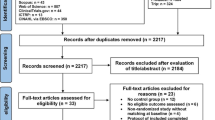Abstract
Objectives
To investigate erosive tooth wear and related variables among adolescents and adults in Israel, utilizing the new basic erosive wear examination (BEWE) scoring system, in an attempt to contribute to the ongoing review, evaluation, and further development of an international standardized index.
Material and methods
A cross-sectional, descriptive, and analytic survey was conducted among 500 subjects of five age groups. Dental erosion was measured according to the new BEWE scoring system. Independent variables included gender, age, origin, education, employment status, and diet. A backward stepwise linear regression model was applied to identify significantly associated variables.
Results
Fifty percent of the survey subjects demonstrated erosive tooth wear; among them, 10 % had distinct erosion of over 50 % of the dental surface. Total BEWE score differences by age groups were statistically significant; as the age increased, the mean total BEWE scores increased (p < 0.001). The association between acidic foods and erosion was evident among the younger population (p = 0.038). In a multiple regression model, age (p < 0.001) and diet (p = 0.044) achieved statistical significance as variables associated with dental erosive wear.
Conclusions
Our study is one of the first to use the BEWE scoring system in an epidemiological survey among adolescents and adults. It was found that the BEWE index is straightforward, easy to conduct, and comfortably accepted by the examinees.
Clinical Relevance
The present findings, together with further international research, should contribute toward continued evaluation of the BEWE system as an international standard and thereby, toward more optimal understanding, evidence-based treatment, and prevention of dental erosive wear.
Similar content being viewed by others
References
Lussi A (2006) Erosive tooth wear–a multifactorial condition of growing concern and increasing knowledge. Monogr Oral Sci 20:1–8
Arnadottir IB, Holbrook WP, Eggertsson H, Gudmundsdottir H, Jonsson SH, Gudlaugssson JO, Saemundsson SR, Eliasson ST, Agustsdottir H (2010) Prevalence of dental erosion in children: a national survey. Community Dent Oral Epidemiol 38:521–526
Ganss C, Young A, Lussi A (2011) Tooth wear and erosion: methodological issues in epidemiological and public health research and the future research agenda. Commun Dent Health 28:191–195
Milosevic A (2011) The problem with an epidemiological index for dental erosion. Br Dent J 211:201–203
Okunseri C, Okunseri E, Gonzales C, Visotcky A, Szabo A (2011) Erosive tooth wear and consumption of beverages among children in the United States. Caries Res 45:130–135
Ganss C (2006) Definition of erosion and links to tooth wear. Monogr Oral Sci 20:9–16
Lussi A, Schlueter N, Rakhmatullina E, Ganns C (2011) Dental erosion–an overview with emphasis on chemical and histopathological aspects. Caries Res 45(suppl):2–12
Young A, Amaechi BT, Dugmore C, Holbrook P, Nunn J, Schiffner U, Lussi A, Ganss C (2008) Current erosion indices–flawed or valid? Summary. Clin Oral Investig 12(suppl):S59–S63
Bartlett D, Ganns C, Lussi A (2008) Basic Erosive Wear Examination (BEWE): a new scoring system for scientific and clinical needs. Clin Oral Investig 12(suppl):S65–S68
Mulic A, Tveit AB, Wang NJ, Hove LH, Espelid I, Skaare AB (2010) Reliability of two clinical scoring systems for dental erosive wear. Caries Res 44:294–299
Lussi A, Schaffner M, Hotz P, Sutter P (1991) Dental erosion in a population of Swiss adults. Community Dent Oral Epidemiol 19:286–290
Taji S, Seow WK (2010) Literature review of dental erosion in children. Aust Dent J 55:358–367
Moynihan P, Petersen PE (2004) Diet, nutrition and the prevalence of dental diseases. Public Health Nutr 7(1A):201–226
Petersen PE, Bourgeois D, Ogawa H, Estupinan–Day S, Ndiaye C (2005) The global burden of oral diseases and risk to oral health. Bull World Health Organ 83:661–669
Ganss C, Lussi A (2006) Diagnosis of erosive tooth wear. Monogr Oral Sci 20:32–43
Abramson JH (2004) Winpepi (pepi for windows): computer programs for epidemiologists. Epidemiol Perspect Innovations 1:6
Margaritis V, Mamai-Homata E, Koletsi-Kounari H, Polychronopoulou A (2011) Evaluation of three different scoring systems for dental erosion: A comparative study in adolescents. J Dent 39:88–93
Mantonanaki M, Koletsi-Kounari H, Mamai-Homata E, Papaioannou W (2013) Dental erosion prevalence and associated risk indicators among preschool children in Athens, Greece. Clin Oral Investig 17:585–593
Dugmore CR, Rock WP (2003) The progression of tooth erosion in a cohort of adolescents of mixed ethnicity. Int J Paed Den 13:295–303
Ganss C, Klimek J, Giese K (2001) Dental erosion in children and adolescents–a cross-sectional and longitudinal investigation using study models. Community Dent Oral Epidemiol 29:264–271
Vered Y, Soskolne V, Zini A, Livny A, Sgan–Cohen HD (2011) Psychological distress and social support are determinants of changing oral health status among an immigrant population from Ethiopia. Community Dent Oral Epidemiol 39:145–153
Sgan-Cohen HD, Evans RW, Whelton H, Vilena RS, MacDougall M, Williams DM, Task Groups IADR-GOHIRA (2013) IADR Global Oral Health Inequalities Research Agenda (IADR-GOHIRA): a call to action. JDR 92:209–211
Sgan-Cohen HD, Mann J (2007) Health, oral health and poverty. JADA 138:1437–1442
WHO (1997) Oral health surveys basic methods, 4th edn. World Health Organization, Geneva
Acknowledgments
This study was supported with a grant from the GABA International. The supporters had no role in data collection and analysis.
Conflict of interest
The authors declare that they have no conflict of interest.
Author information
Authors and Affiliations
Corresponding author
Rights and permissions
About this article
Cite this article
Vered, Y., Lussi, A., Zini, A. et al. Dental erosive wear assessment among adolescents and adults utilizing the basic erosive wear examination (BEWE) scoring system. Clin Oral Invest 18, 1985–1990 (2014). https://doi.org/10.1007/s00784-013-1175-0
Received:
Accepted:
Published:
Issue Date:
DOI: https://doi.org/10.1007/s00784-013-1175-0




